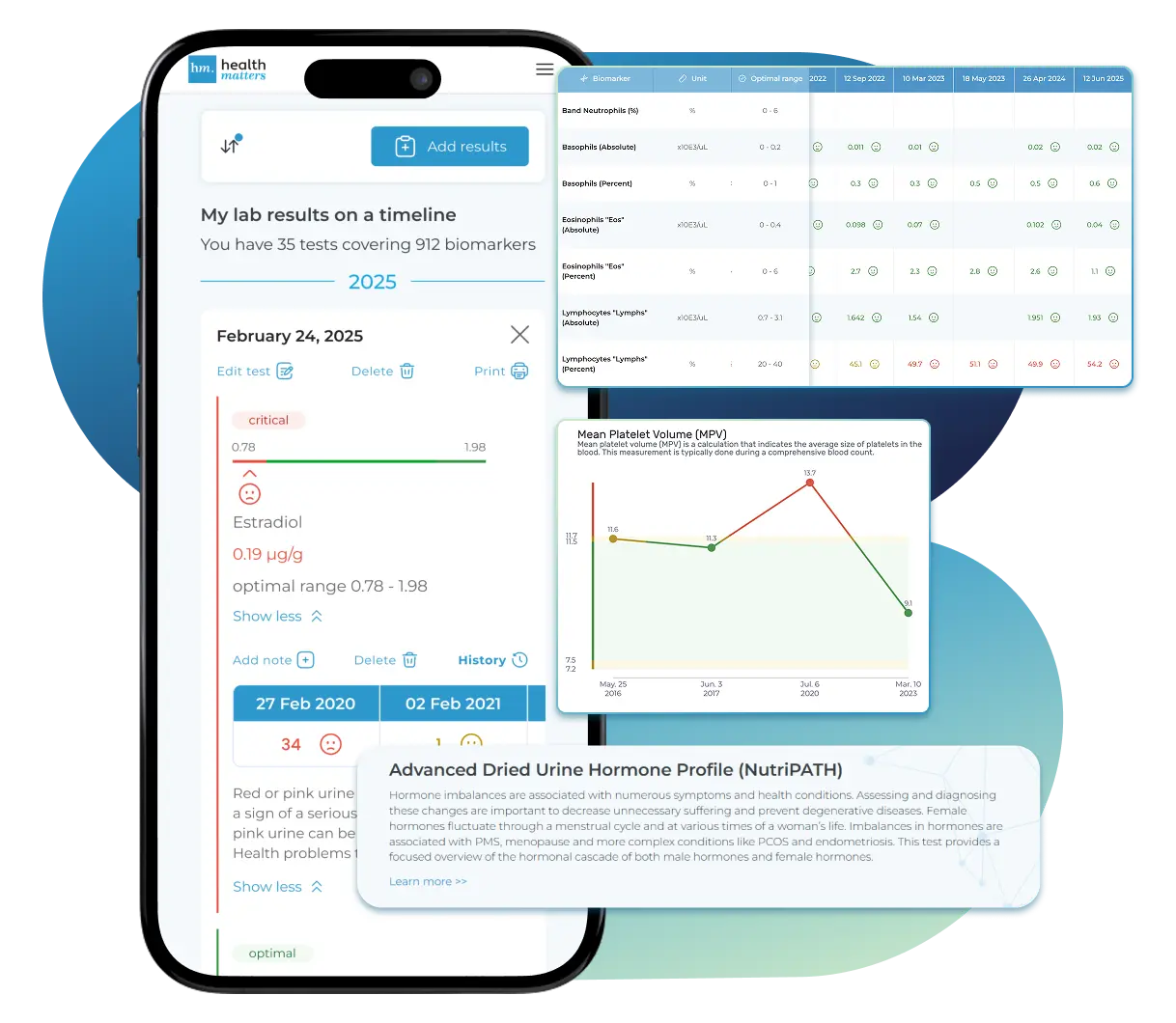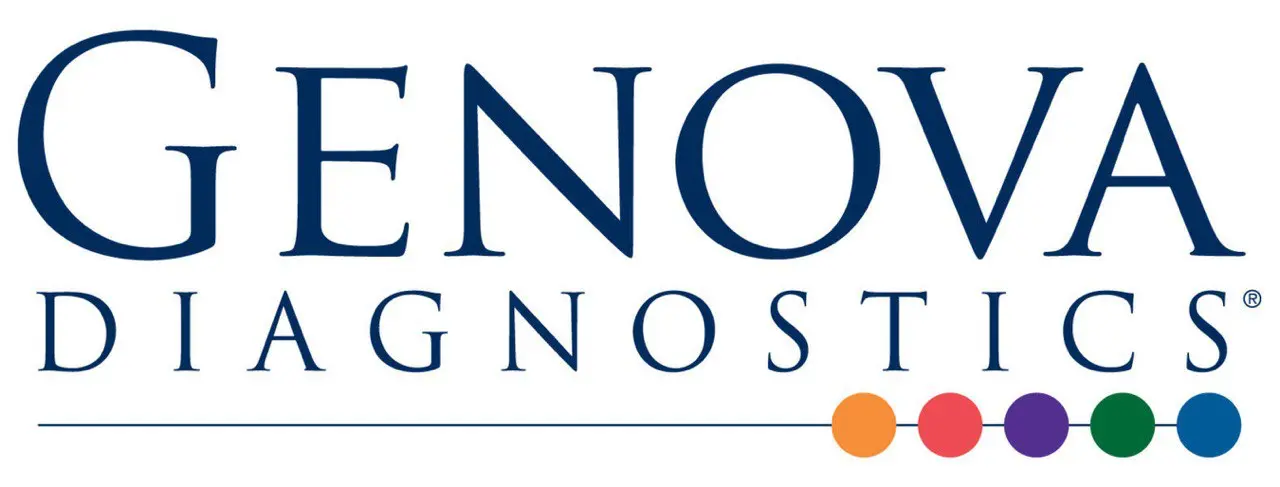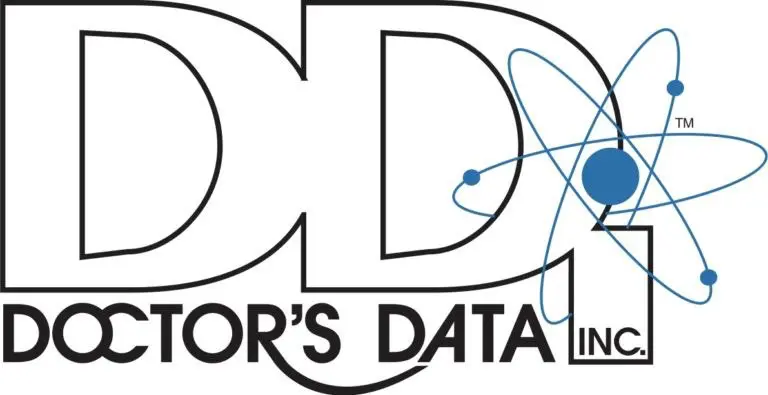Tryptophan is an essential amino acid that serves as the biochemical starting point for several key pathways in the body. It is the primary precursor for serotonin—the neurotransmitter responsible for emotional balance, sleep regulation, and relaxation—and, by extension, for melatonin, which governs circadian rhythm and sleep quality. Beyond neurotransmission, tryptophan also plays a vital role in immune modulation, energy production, and cellular repair, making it one of the most metabolically significant amino acids tested in the Neurotransmitter XL panel.
Because the body cannot synthesize tryptophan, it must be obtained from dietary sources such as turkey, eggs, salmon, tofu, legumes, nuts, and seeds. Once absorbed, tryptophan follows multiple metabolic routes, including:
Serotonin pathway – for neurotransmitter and melatonin synthesis.
Kynurenine pathway – for immune regulation, production of NAD+ (nicotinamide adenine dinucleotide), and energy metabolism.
Protein synthesis – incorporation into structural and enzymatic proteins.
The balance between serotonin production and kynurenine metabolism provides deep insight into how the body manages stress, inflammation, and mood.
On the Neurotransmitter XL panel, tryptophan is measured alongside serotonin, kynurenine, quinolinic acid, and NAD+ to evaluate how efficiently the body converts this amino acid into neurotransmitters or energy-related cofactors.
This is particularly important because tryptophan metabolism shifts under stress, inflammation, or immune activation. When chronic stress or inflammatory cytokines trigger the enzyme indoleamine 2,3-dioxygenase (IDO), tryptophan is diverted away from serotonin synthesis toward the kynurenine pathway. This can result in:
Reduced serotonin and melatonin production, leading to mood changes, fatigue, and sleep disturbances.
Accumulation of neurotoxic metabolites such as quinolinic acid, which can impair mitochondrial function.
Reduced NAD+ formation, decreasing ATP output and energy availability.
By examining tryptophan in conjunction with its downstream metabolites, the panel helps identify whether the imbalance arises from nutritional deficiencies, inflammatory stress, or mitochondrial dysfunction.
Tryptophan → 5-HTP → Serotonin (5-HT) → Melatonin
Tryptophan hydroxylase (TPH) converts tryptophan to 5-HTP (requires BH4, iron, and oxygen).
Aromatic L-amino acid decarboxylase (AADC) converts 5-HTP to serotonin (requires vitamin B6).
In the pineal gland, serotonin is acetylated and methylated to form melatonin, a process dependent on SAM (S-adenosylmethionine).
Deficiencies in vitamin B6, BH4, folate, B12, magnesium, or SAM can slow this pathway, resulting in low serotonin and melatonin levels.
Tryptophan → Kynurenine → Quinolinic Acid → NAD+
When stress or immune activation induces IDO or tryptophan 2,3-dioxygenase (TDO), more tryptophan is converted into kynurenine and its downstream metabolites.
This pathway has dual roles: it helps regulate immune responses, but excessive activation can deplete serotonin and produce oxidative or neurotoxic byproducts.
Markers like kynurenine, quinolinic acid, NAD+, and neopterin on the panel indicate how this pathway is functioning.
Elevated kynurenine – reflects inflammatory activation or stress load.
High quinolinic acid – suggests oxidative stress and potential mitochondrial toxicity.
Low NAD+ – points to impaired conversion or nutrient depletion (e.g., low niacin).
Tryptophan competes with other large neutral amino acids (LNAAs) for transport across the blood–brain barrier.
High-protein meals can limit its uptake into the brain.
Carbohydrate intake can improve tryptophan availability by promoting insulin-mediated uptake of competing amino acids.
Low dietary tryptophan or restricted diets (e.g., vegan or low-protein) can therefore limit serotonin synthesis.
Efficient tryptophan metabolism requires:
Vitamin B6 for decarboxylation into serotonin.
Folate, B12, and SAM for methylation processes.
Vitamin C and iron for hydroxylation steps.
Niacin (B3) for NAD+ generation.
Deficiencies in these cofactors can result in incomplete conversion and accumulation of intermediary metabolites.
Chronic stress elevates cortisol and inflammatory cytokines (e.g., interferon-γ), activating the IDO enzyme that diverts tryptophan from serotonin to kynurenine.
This can cause:
Decreased serotonin and melatonin (affecting mood and sleep)
Elevated quinolinic acid and kynurenine (increasing oxidative and nitrosative stress)
Reduced NAD+ synthesis (impairing mitochondrial energy production)
This “tryptophan steal” phenomenon explains why prolonged stress often leads to low mood, fatigue, and burnout symptoms.
The gut microbiome influences tryptophan metabolism directly. Certain bacteria metabolize tryptophan into indoles, which regulate immune and intestinal barrier function.
Chronic gut inflammation or dysbiosis can therefore lower tryptophan availability or skew its metabolic pathways.
Mitochondrial health influences NAD+ turnover and the efficiency of tryptophan conversion.
Low ATP production, oxidative stress, or environmental toxin exposure (e.g., phthalates) can inhibit key enzymes like quinolinic acid phosphoribosyltransferase (QPRT), leading to NAD+ deficiency even when tryptophan intake is adequate.
| Related Marker | Interpretation Insight |
|---|---|
| Serotonin | Low serotonin with low tryptophan suggests precursor deficiency; low serotonin with normal tryptophan suggests pathway blockage or cofactor deficiency. |
| Kynurenine | Elevated levels indicate stress- or immune-driven diversion of tryptophan metabolism. |
| Quinolinic Acid | High levels point to oxidative stress and possible mitochondrial impairment. |
| NAD+ and Niacin Markers | Low levels reflect impaired energy metabolism and incomplete conversion of quinolinic acid to NAD+. |
| Neopterin | Elevated neopterin suggests immune activation (via interferon-γ) leading to IDO stimulation. |
| SAM / SAH Ratio | Low ratio indicates reduced methylation capacity affecting melatonin synthesis and overall neurotransmitter balance. |
Inadequate dietary intake or absorption issues
Chronic inflammation or stress diverting tryptophan to the kynurenine pathway
Cofactor deficiencies (vitamin B6, folate, B12, iron, or BH4) limiting serotonin synthesis
Malabsorption or gut dysbiosis reducing precursor availability
Mitochondrial dysfunction lowering NAD+ conversion efficiency
Symptoms may include low mood, anxiety, fatigue, poor sleep, cravings for carbohydrates, and digestive issues.
Less common, but may occur with:
Reduced conversion efficiency (enzyme or cofactor deficiencies)
Blocked downstream metabolism (e.g., IDO or TDO inactivity)
Supplementation with tryptophan or 5-HTP
Persistent elevation without proportional increases in serotonin or kynurenine may indicate metabolic stagnation or impaired enzyme activity.
Imbalances in tryptophan metabolism can have wide-ranging effects:
Mood and sleep disturbances due to low serotonin and melatonin
Neuroinflammation and fatigue from excess quinolinic acid
Impaired cellular energy due to low NAD+ and mitochondrial strain
Immune dysregulation through disrupted kynurenine signaling
Addressing the root cause—whether nutritional, inflammatory, or mitochondrial—can help restore balanced tryptophan utilization.
Ensure adequate dietary protein with balanced amino acid intake.
Support serotonin synthesis with vitamin B6, folate, B12, magnesium, iron, and BH4 cofactors.
Mitigate chronic stress through mindfulness, restorative sleep, and moderate exercise.
Support mitochondrial health with niacin (B3), NAD+ precursors, CoQ10, and antioxidants.
Promote gut health via probiotics, prebiotics, and anti-inflammatory nutrition.
Consider targeted supplementation with tryptophan or 5-HTP only under clinical supervision, especially if taking SSRIs or other serotonergic agents.
Tryptophan sits at the crossroads of neurotransmitter synthesis, immune regulation, and mitochondrial energy metabolism. Low levels or pathway imbalances can reveal why an individual feels fatigued, anxious, or unable to recover from stress. On the Neurotransmitter XL panel, tryptophan results—interpreted alongside serotonin, kynurenine, NAD+, and neopterin—offer a powerful lens into how the body converts nutrients into emotional and physical vitality.

Import lab results from multiple providers, track changes over time, customize your reference ranges, and get clear explanations for each result. Everything is stored securely, exportable in one organized file, and shareable with your doctor—or anyone you choose.
Cancel or upgrade anytime

A decreased tryptophan level on the Neurotransmitter XL panel suggests that the body may not be receiving, absorbing, or utilizing this essential amino acid efficiently. Because tryptophan is the precursor to serotonin, melatonin, and nicotinamide adenine dinucleotide (NAD+), low levels can disrupt multiple systems—impacting mood, sleep, stress resilience, energy production, and immune regulation. When tryptophan becomes depleted, serotonin synthesis declines, sleep quality worsens, and the body may divert remaining stores toward the kynurenine pathway, especially under chronic stress or immune activation.
Tryptophan is an essential amino acid—the body cannot produce it internally. Insufficient intake of protein-rich foods (such as poultry, eggs, fish, or legumes) can directly lower circulating levels. Additionally, malabsorption syndromes, gut inflammation, or microbiome imbalances can reduce intestinal absorption, even when dietary intake is adequate.
Prolonged stress increases cortisol and activates indoleamine 2,3-dioxygenase (IDO)—an enzyme that diverts tryptophan away from serotonin and toward the kynurenine pathway. This “tryptophan steal” reduces serotonin synthesis, promotes neurotoxic byproducts like quinolinic acid, and depletes mitochondrial NAD+, which is essential for energy metabolism. Over time, this shift contributes to fatigue, low mood, and burnout.
During immune or inflammatory responses, interferon-γ and other cytokines further stimulate IDO, accelerating tryptophan depletion. Elevated neopterin levels on the panel often accompany this pattern, indicating active immune-mediated diversion of tryptophan metabolism. This mechanism is common in chronic inflammatory or autoimmune conditions.
Efficient conversion of tryptophan into serotonin and NAD+ requires several cofactors:
Vitamin B6 (for serotonin synthesis)
Folate, B12, and BH4 (for methylation and hydroxylation)
Niacin (B3) (for NAD+ synthesis)
Iron and magnesium (for enzymatic reactions)
Deficiencies in these nutrients can hinder tryptophan’s normal metabolic flow, resulting in accumulation of incomplete intermediates or redirection into stress pathways.
Up to 90% of serotonin is produced in the gut. Dysbiosis, intestinal inflammation, or “leaky gut” can impair local tryptophan metabolism and reduce precursor availability for serotonin synthesis. Certain beneficial gut bacteria—like Bifidobacterium and Lactobacillus—help convert tryptophan into serotonin and other indole derivatives that maintain intestinal and nervous system balance.
Intense physical training, chronic sleep loss, caffeine, and stimulant use increase catecholamine turnover and stress hormone production, consuming tryptophan reserves faster than they can be replenished.
Because tryptophan influences both neurotransmitter and mitochondrial systems, low levels can manifest as:
Low mood, depression, or emotional flatness
Anxiety, irritability, or poor stress tolerance
Fatigue, low motivation, or burnout
Sleep disturbances (especially early waking or insomnia)
Increased pain sensitivity
Digestive discomfort or altered bowel patterns
Carbohydrate cravings (a compensatory mechanism to increase serotonin)
| Related Marker | Interpretation Insight |
|---|---|
| Serotonin | Low serotonin alongside low tryptophan indicates substrate deficiency; low serotonin with normal tryptophan suggests cofactor or enzyme block. |
| Kynurenine / Quinolinic Acid | Elevated levels with low tryptophan suggest immune or stress-induced diversion. |
| NAD+ / Niacin Markers | Low values reflect impaired energy production due to reduced tryptophan conversion. |
| Neopterin | High values indicate immune activation driving IDO activity. |
| BH4 and B6 Markers (Cystathionine, Methylmalonic Acid) | Elevated markers suggest cofactor insufficiency limiting serotonin synthesis. |
This integrated analysis helps determine whether low tryptophan arises from nutrient deficiency, inflammation, immune activity, or stress-related metabolic shifts.
Persistent tryptophan depletion can lead to:
Serotonin and melatonin deficiency, affecting mood, sleep, and circadian rhythm.
Reduced NAD+ production, impairing mitochondrial energy metabolism.
Neuroinflammation, driven by excess kynurenine and quinolinic acid.
Emotional instability, fatigue, and burnout, linked to low neurotransmitter synthesis.
Early recognition and intervention are key to preventing downstream neurochemical and metabolic imbalances.
Optimize protein intake: Include tryptophan-rich foods (turkey, salmon, eggs, oats, pumpkin seeds).
Replete cofactors: Ensure adequate B6, B12, folate, niacin (B3), magnesium, iron, and zinc.
Mitigate chronic stress: Prioritize relaxation, restorative sleep, and moderate exercise.
Support gut health: Address inflammation and encourage beneficial microbiota through probiotics and fiber-rich foods.
Reduce inflammatory load: Manage chronic infections, metabolic stress, and environmental toxin exposure.
Monitor supplementation carefully: L-tryptophan or 5-HTP may support serotonin synthesis under medical supervision, especially if not using serotonergic medications.
Low tryptophan levels signify a disruption in the body’s ability to generate serotonin, melatonin, and NAD+—core molecules for mood, sleep, and energy regulation. Whether due to stress, inflammation, nutrient deficiency, or poor gut function, this imbalance can contribute to fatigue, anxiety, and emotional instability. Interpreting tryptophan alongside serotonin, kynurenine, NAD+, neopterin, and B-vitamin markers on the Neurotransmitter XL panel provides a detailed picture of underlying biochemical imbalances.
Laboratories
We accept reports from any lab, so you can easily collect and organize all your health information in one secure spot.











Pricing Table
Choose the plan that fits you — and turn scattered lab reports into clear insights you can finally use.
Pick a plan that fits you — and turn scattered lab reports into clarity.
Personal plans
Professional plan
$15/ month
Access your lab reports, explanations, and tracking tools.
$250/ once
Pay once, access everything—no monthly fees, no limits.
Professional plan
$45/ month
Designed for professionals managing their clients' lab reports
About membership
 Import Lab Results from Any Source
Import Lab Results from Any Source
Easily upload lab results from any provider, whether it's a hospital, independent lab, or home testing service. We support PDFs, scanned documents, and JPEGs from patient portals. No need to log in to multiple platforms — everything is centralized in one secure space.
Easily upload lab results from any provider — we support PDFs, scans, and images. Keep all your reports organized in one secure place.
 See Your Health Timeline
See Your Health Timeline
Every lab result is automatically organized on a chronological timeline, giving you a complete picture of your health journey. Whether you're tracking a condition, managing treatments, or staying proactive, the timeline helps you and your doctor understand how things progress over time.
Every lab result is automatically organized on a chronological timeline, giving you a complete picture of your health journey.
 Understand What Your Results Mean
Understand What Your Results Mean
Whether it's a blood test, GI panel, urinalysis, or something else, lab reports measure numerous biomarkers that reveal what's happening inside your body. Our extensive database covers over 10,000 biomarkers, providing clear, simple explanations of what each result means and how you can take action—no matter your membership level. Say goodbye to confusion and get the insights you need to better understand your health.
Our database covers over 10,000 biomarkers with clear, simple explanations—so you can finally understand your results and what to do next.
 Enter Your Lab Reports Yourself — Always Free
Enter Your Lab Reports — Always Free
Enter Your Lab Reports Yourself — Always Free
Enter Your Lab Reports — Always Free
If you'd like to handle inputting your health data into your account, you can do so with our easy-to-use data entry forms. Our user-friendly form is designed to guide you through the quick and easy submission process, making it simple to keep track of your health metrics. This is available to both Complete plan and Unlimited plan members.
Our user-friendly form guides you through a quick, simple submission process, making it easy to enter your health metrics.
Add your results anytime with our easy entry form. It's quick, guided, and helps you stay organized — free for all members.
 Visualize Your Results
Visualize Your Results
View your lab data through easy-to-read graphs and tables. Quickly spot patterns, track changes, and compare results across different dates — all without digging through multiple reports. You can also select and compare graphs of specific biomarkers side-by-side to better understand how they relate and change over time.
See your lab reports in clear graphs and tables. Spot patterns, track changes, and compare results over time — all in one place.
 Export Your Complete Lab History in a Single File
Export Your Complete Lab History
Export Your Complete Lab History in a Single File
Export Your Complete Lab History
After collecting lab results from different providers, you can download your entire history combined into a single file. Choose from PDF, Excel, or CSV formats to easily review, share, or get a second opinion—no more juggling multiple reports.
After collecting lab results from different providers, you can download your entire history combined into a single file.
 Comprehensive Data Entry Service for Your Reports
Data Entry Service for Your Reports
Comprehensive Data Entry Service for Your Reports
Data Entry Service for Your Reports
Our inclusive service handles the data entry for your lab reports. Just submit your information and we'll take care of the rest. Complete plan members receive one report entered for free, then $15 per report after that. Unlimited plan members receive ten report entries for free, then $15 per report after that.
Our inclusive service handles the data entry for your lab reports. Just submit your information and we'll take care of the rest.
 Securely Share With Anyone You Trust
Securely Share With Anyone You Trust
Whether you're working with a doctor, nutritionist, caregiver, or wellness coach, you can securely share your complete lab history by sending an invite link to anyone you trust. You have full control over who sees your information and for how long, ensuring your privacy and peace of mind at every step.
Share your full lab history with your doctor, nutritionist, or coach using a secure invite link.
Discover






I have been using Healthmatters.io since 2021. I travel all over the world and use different doctors and health facilities. This site has allowed me to consolidate all my various test results over 14 years in one place. And every doctor that I show this to has been impressed. Because with any health professional I talk to, I can pull up historical results in seconds. It is invaluable. Even going back to the same doctor, they usually do not have the historical results from their facility in a graph format. That has been very helpful.
Anthony
Unlimited Plan Member since 2021

What fantastic service and great, easy-to-follow layouts! I love your website; it makes it so helpful to see patterns in my health data. It's truly a pleasure to use. I only wish the NHS was as organized and quick as Healthmatters.io. You've set a new standard for health tracking!
Karin
Advanced Plan Member since 2020

As a PRO member and medical practitioner, Healthmatters.io has been an invaluable tool for tracking my clients' data. The layout is intuitive, making it easy to monitor trends and spot patterns over time. The ability to customize reports and charts helps me present information clearly to my clients, improving communication and outcomes. It's streamlined my workflow, saving me time and providing insights at a glance. Highly recommended for any practitioner looking for a comprehensive and user-friendly solution to track patient labs!
Paul
Healthmatters Pro Member since 2024
Healthmatters is a personal health dashboard that helps you organize and understand your lab results. It collects and displays your medical test data from any lab in one secure, easy-to-use platform.
With a Healthmatters account, you can:
Professionals can also analyze client data more efficiently and save time managing lab reports.
Healthmatters.io personal account provides in-depth research on 4000+ biomarkers, including information and suggestions for test panels such as, but not limited to:
You can combine all test reports inside your Healthmatters account and keep them in one place. It gives you an excellent overview of all your health data. Once you retest, you can add new results and compare them.
If you are still determining whether Healthmatters support your lab results, the rule is that if you can test it, you can upload it to Healthmatters.
While we work with many popular labs, we welcome reports from lots of other places too.
It's as simple as this: if you can get a test done, you can upload it to Healthmatters and we can interpret results from any lab out there. If laboratories can analyze it, we can interpret it.
If you're on the hunt for a specific biomarker, contact us and we'll add it to our database. Anything from blood, urine, saliva, or stool can be uploaded, understood, and tracked with your Healthmatters account.
The Complete Plan ($15/month) is perfect for individuals who want ongoing access to their health data. It includes unlimited lab imports, visual tracking, custom ranges, result explanations, full account exports, and secure sharing — all with a simple monthly subscription. You can cancel anytime and restart your plan whenever you're ready — your data will still be there waiting for you. You can also upgrade to the Unlimited Plan at any time, with the cost prorated based on what you've already paid.
The Unlimited Plan ($250 one-time) is also designed for individuals but offers lifetime access with no ongoing subscription. You'll get all the same features as the Complete Plan, plus a larger initial data entry allowance (10 reports), making it a great choice if you prefer a one-time payment and long-term use without monthly fees.
In short:
There are two ways to add your test reports to your Healthmatters account. One option is to input the data using the data entry forms. The other method is to utilize our "Data entry service."
Our data entry forms offer an easy, fast, and free way for you to input the reports yourself. Self-entry allows you to add an unlimited number of reports at no cost. We make the self-entry process user-friendly, providing dozens of templates that pre-populate the most popular laboratory panels and offering instant feedback on entered values.
For those who prefer assistance, we offer a "Data entry service" to help you input your data. Simply attach an image or file of your lab test results, and a qualified team member from our data entry team will add the results for you.
We support various file types, including PDFs, JPGs, or Excel. This service is particularly useful if you have many reports to upload or if you're too busy to handle the data entry yourself.
Our Data Entry Service is for when you don't want to manually type in your lab results yourself. You simply upload your report (PDF, image, or screenshot), and our trained team enters the information into your Healthmatters account for you — accurately and neatly organized, ready to view in graphs, tables, and timelines.
The $15 per report covers the time and care it takes for a real person to review your file, make sure each result is entered correctly, and double-check for accuracy. This ensures your health data is precise and easy to work with — without you having to spend the time doing it yourself.
Prefer to do it yourself? You can always use our free self-entry tool to add results manually — it just takes a bit more time and attention.
For users on the Complete monthly plan, the first report is entered free of charge, and each additional report incurs a fee of $15.
Unlimited account holders enjoy the entry of ten reports without charge. Subsequent reports are subject to a $15 fee per report.
Additionally, users on the Complete plan can upgrade to a yearly subscription from the account settings. The annual subscription includes a data entry service for five reports.
All professional accounts allow you to import and onboard an unlimited number of clients and their lab results. The distinction between professional plans lies solely in the data entry service.
The Pro Monthly Plus plan is priced at $75 per month and includes a data entry service for five reports each month. Additional reports can be self-entered at no extra cost or, if preferred, you can use our data entry service for an additional fee of $15 per report.
The Pro Monthly plan is priced at $45 per month and does not include a data entry service. Self-entry is free for an unlimited number of reports, and you can opt for the data entry service at a fee of $15 per report.
You also have the option to upgrade to higher monthly or to annual plans, which come with substantial discounts. All upgrades can be done directly from your account.
Simply log in and navigate to your account settings to cancel your subscription. Scroll down to locate the 'Cancel' button at the bottom of the page. Ensure you cancel at least one day before the renewal date to prevent any charges. Once cancellation is requested, the subscription remains active until the conclusion of the current billing cycle.
Our goal has been to make your Healthmatters account as intuitive as possible.
We've crafted multiple ways for you to navigate your data, whether you're glancing at a single report or delving into your historical test reports.
1. Graph View:Dive into a visual journey with our biomarker graphs, showcasing over 40 data points. Combining years of results unveils trends, empowering you to make informed decisions. Our visualization tools make it a breeze to compare and understand changes over time, even if your results are from different labs. A search function and filters simplify the exploration of extensive data, allowing you to focus on what needs attention.
2. All Tests ViewExplore neatly organized reports on a timeline, highlighting crucial details like dates, critical results, and lab/panel names. Each report opens up to reveal in-depth descriptions and additional recommendations for each biomarker. The history of previous results is just a click away, and you can download a comprehensive report for deeper insights. Color-coded and user-friendly, it's designed for easy reading, understanding, and navigation.
3. Table View:For a holistic view of all biomarkers side by side, our table view is your go-to. Results are neatly displayed in a categorized and dated table, ideal for those with an extensive test history. Utilize sorting, filters, and color-coding to enhance your analysis and gain extra insights.
Yes, you can download your information anytime. We offer two easy ways to export your lab data:
This makes it simple to save, back up, or share your health data whenever you need.
Yes, you can print your report. To do so, navigate to "All tests" and open the report you wish to print. You'll find a print button in the right corner of the report. Click on it, and your browser's print window will open. If you prefer to print in a bigger typeface, adjust the scale using the print window settings.
Yes, you can! We highly recommend activating Two-Factor Authentication (2FA) for your account. To do so, please navigate to the "Profile and Security" section of your account, where you will find instructions for activating 2FA.
Yes, you can. When entering values for the biomarker, you will see an "Edit Range" button. Click this button, and you'll have the option to enter a custom range.
A personal account is all about keeping your own lab test results in check. It's just for you and your personal use.
The professional account is designed for health professionals who wish to track and organize their clients' laboratory results.
To learn more about Healthmatters Pro, please refer to the professional page.
At HealthMatters, we're committed to maintaining the security and confidentiality of your personal information. We've put industry-leading security standards in place to help protect against the loss, misuse, or alteration of the information under our control. We use procedural, physical, and electronic security methods designed to prevent unauthorized people from getting access to this information. Our internal code of conduct adds additional privacy protection. All data is backed up multiple times a day and encrypted using SSL certificates. See our Privacy Policy for more details.

